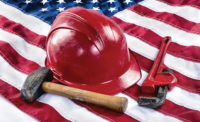Survey reports stable EHS budgets, staffs & incomes

Safety and health professionals (full-timers) and practitioners (part-timers) are in stable, generally positive positions entering the new year, according to reader research conducted by ISHN magazine in October, 2017.
Let’s start by using income as a leading indicator of the state of the EHS nation. Income levels for safety and health pros are healthy. The median current annual gross salary of those surveyed is $88,250. (Most survey respondents are full-time safety and health professionals with more than 20 years’ experience.) And 74 percent of respondents indicated that their 2017 annual gross salary was slightly or much higher than the previous year. Keep in mind the U.S. median household income in 2016 was $59,039, according to the U.S. Census Bureau. That’s almost $30,000 less than the average income of safety and health pros.
Other leading indicators of the state of the profession are reflected in budget and staffing plans for 2018. Safety and health department budgets will increase slightly in ’18 for 41 percent of survey respondents, and remain the same for 43 percent. The same dynamic holds true for safety and health department staffing: 28 percent expect staff levels to increase slightly (mostly in large corporations with more than 5,000 employees) and 63 percent expect staffing to hold the line
Significant budget increases or decreases are rare: only three percent expect large funding increases, and only three percent expect large fall-offs. Budgets will decrease slightly for 11 percent. Only one percent anticipate severe staff cutbacks, and six percent expect slight staff reductions. Two percent expect significant staff additions.
Biggest challenges
In 2018 the biggest challenge safety and health pros face remains the same as it has for decades, if not the history of the field: getting all company personnel onboard with safety processes and procedures – engagement and buy-in – and building a sustainable safety culture that involves all levels of the organization.
Another ongoing challenge: making the business case for safety to upper management. This is the second biggest challenge facing professionals in ’18, and it’s especially true in smaller companies.
Still, several positive indicators are trending in the safety world. Senior executives spend more time on safety activities than 10-15 years ago, according to 58 percent of respondents. And 58 percent say employees today exhibit more consistently safe work behaviors than 10-15 years ago.
Safety and health pros in mid-size and large corporations are more likely to signal these positive changes. In smaller companies without full-time safety and health pros on staff, getting employer and employee support for safety is more challenging. Still, less than 20 percent of all survey respondents report senior leaders and line employees have not improved their safety awareness and involvement since 2000-2005.
Whither OSHA?
With the change in administrations and the Trump White House’s deregulatory emphasis, it’s no surprise almost half (48 percent) of those surveyed say OSHA is no longer the driving force it once was motivating companies to protect workers. Almost one-third (29 percent) of respondents, most with small firms, still say OSHA compliance is job one. In small companies without full-time safety and health professionals and with limited safety and health budgets and knowledge, OSHA compliance is often the only safety activity undertaken.
Sustainability grows as a safety function
Most pros today are taking on more sustainability-related jobs. Sixty percent of those surveyed are currently involved in their company’s sustainability strategies and goals; 19 percent plan to be more involved in the next three years; only 21 percent do not plan on being involved in sustainability activities in the next three years.
Demographic trends
The safety and health profession is slowly but surely diversifying. Currently 23 percent, almost one-quarter, are women. Just look at who is attending safety and health conferences these days. The field is still dominated by baby boomers – 73 percent are age 50 or older. More specifically, 40 percent are between ages 50-59 and 33 percent are older than age 60. The mean age of those surveyed is 55.
Request a sample copy from Clear Seas Research
Source: Clear Seas Research, 2401 W. Big Beaver Rd. Troy, MI 48084; 248.786.1683; connect@clearseasresearch.com. Clear Seas Research was born out of a market need for business-to-business marketing research solutions in a business world based on trust. Clients choose Clear Seas Research for the following reasons: Unparalleled industry, vertical B-to-B knowledge in these industries (our specialty is B-to-B, not consumer, research.); Deep portfolio of primary (that is, Voice-of-Customer) syndicated research reports. (Not recycled government data. Not rehashed Google searches.); Unrivaled sample from our double opt-in proprietary panel - myCLEARopinion Panel.
|
Friends of Industrial Safety & Hygiene News We would like to share some exciting news with you and introduce Darrell Dal Pozzo as the new Publisher for ISHN magazine. Darrell brings more than 20 years of business-to-business media experience with him, the last seven years at BNP Media as Senior Group Publisher of multiple brands. Previously Darrell was with Reed Business Information and Cahners Publishing in multiple digital media, sales and management positions for 12 years. Darrell will focus his efforts on strategic initiatives that deliver maximum value to ISHN’s marketing partners, while continuing to offer the best editorial in the marketplace. |
Looking for a reprint of this article?
From high-res PDFs to custom plaques, order your copy today!







